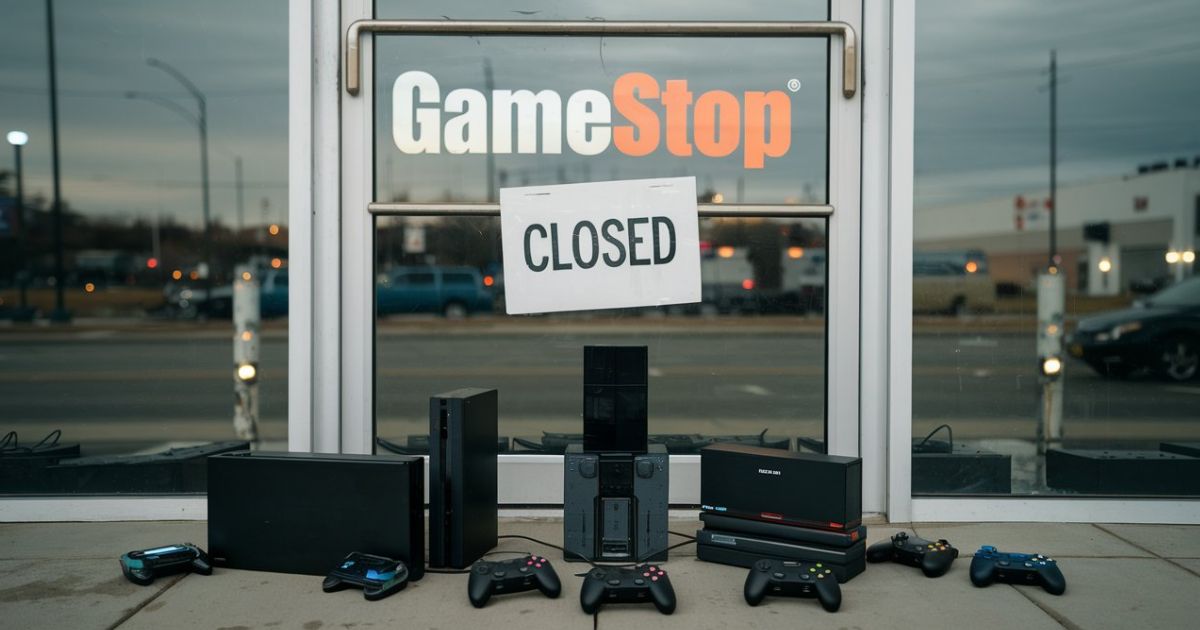In the annals of stock market history, few stories have captured the imagination quite like the GameStop February-October Irwin Decrypt saga.
This rollercoaster ride of financial intrigue, social media frenzy, and Wall Street drama has left an indelible mark on the world of investing.
Let’s dive deep into this extraordinary tale that reshaped our understanding of market dynamics and the power of retail investors.
February: The GameStop Frenzy Begins
The year 2021 kicked off with a bang in the financial world. GameStop, a struggling brick-and-mortar video game retailer, suddenly found itself at the center of a stock market storm.
The company’s shares, which had been languishing in the single digits, skyrocketed to dizzying heights, leaving Wall Street veterans scratching their heads.
What sparked this unprecedented surge? It all began on Reddit’s WallStreetBets forum, where a group of retail investors identified GameStop as a potential target for a short squeeze.
These savvy internet sleuths noticed that hedge funds had heavily shorted GameStop’s stock, betting on its decline. In a classic David vs. Goliath scenario, these retail investors decided to take on the Wall Street giants.
As more and more individual investors piled into GameStop stock, its price began to soar. The frenzy reached fever pitch when the stock hit an eye-watering $483 per share on January 28th, up from just $17.25 at the start of the year. This meteoric rise caught many professional investors off guard and sent shockwaves through the financial markets.
The Short Squeeze Explained
To understand the GameStop phenomenon, we need to delve into the mechanics of a short squeeze. Short selling is a strategy where investors borrow shares of a stock they believe will decrease in value, sell them, and then buy them back later at a lower price to profit from the difference. However, this strategy can backfire spectacularly if the stock price rises instead.
In GameStop’s case, the massive influx of buying pressure from retail investors forced short-sellers to buy back the stock at higher prices to cover their positions. This, in turn, drove the price even higher, creating a feedback loop that sent the stock into the stratosphere. It was like watching a financial game of hot potato, with short-sellers scrambling to avoid being left holding the bag.
Here’s a simplified breakdown of how the short squeeze played out:
- Hedge funds heavily short GameStop stock
- Retail investors notice and start buying shares
- Stock price begins to rise
- Short-sellers are forced to buy back shares at higher prices
- More buying pressure drives the price even higher
- Rinse and repeat
This vicious cycle caught many professional investors off guard, leading to billions in losses for some hedge funds and eye-popping gains for retail investors who got in early.
The Role of Social Media
The GameStop saga wouldn’t have been possible without the power of social media. Platforms like Reddit, Twitter, and YouTube became the virtual water coolers where retail investors gathered to share information, strategies, and memes. The WallStreetBets subreddit, in particular, emerged as ground zero for the GameStop movement.
At the heart of this social media frenzy was Keith Gill, better known by his online aliases “Roaring Kitty” on YouTube and “Deep FingValue” on Reddit.
Gill’s detailed analysis of GameStop’s potential and his unwavering belief in the company’s turnaround prospects inspired thousands of retail investors to join the cause.
The meme-fueled momentum behind GameStop was unlike anything Wall Street had ever seen. Investors rallied around battle cries like “diamond hands” (holding onto stocks despite volatility) and “to the moon” (expectations of astronomical price increases).
This new language of investing, born on social media, bewildered traditional financial analysts and showcased the growing influence of online communities in the stock market.
March to June: The Aftermath and Consolidation
As the dust began to settle on the initial GameStop frenzy, the period from March to June 2021 was marked by volatility and introspection. The stock price, while still elevated compared to its pre-frenzy levels, experienced significant fluctuations as the market tried to make sense of what had just occurred.
During this time, regulatory bodies like the Securities and Exchange Commission (SEC) began to take a closer look at the events surrounding GameStop. Questions were raised about potential market manipulation, the role of social media in stock trading, and the fairness of certain trading platform practices.
Many retail investors who had joined the GameStop movement faced a crucial decision: hold onto their shares in hopes of further gains (diamond hands) or sell and lock in their profits (paper hands). This period tested the resolve of the WallStreetBets community and separated the true believers from those who were just along for the ride.
Also Read: [Noblocc] Kicked for Being AFK: The Ultimate Guide to Staying in the Game
Ryan Cohen’s Influence
Amidst the chaos, a new player emerged as a central figure in the GameStop story: Ryan Cohen. The co-founder of successful e-commerce pet supply company Chewy, Cohen had acquired a significant stake in GameStop in 2020 and joined its board of directors in January 2021.
Cohen’s vision for GameStop was nothing short of revolutionary. He saw the potential to transform the struggling retailer into a technology-driven powerhouse, leveraging its brand recognition and customer base to compete in the digital age. His plans included:
- Expanding GameStop’s e-commerce capabilities
- Exploring new product categories beyond video games
- Improving customer experience both online and in-store
- Investigating opportunities in emerging technologies like blockchain and NFTs
Cohen’s involvement brought a new level of legitimacy to the GameStop story. Many investors saw his track record of success with Chewy as a promising sign for GameStop’s future. His tweets and public statements often sent the stock price soaring, highlighting the immense influence he held over investor sentiment.
The Irwin Decrypt
As the GameStop saga unfolded, a mysterious document known as the “Irwin decrypt” began circulating among investors. Named after a pseudonymous analyst, this document provided a detailed bull case for GameStop’s long-term potential.
The Irwin decrypt became a rallying point for those who believed in GameStop’s transformation beyond just a short squeeze play.
Key points from the Irwin decrypt included:
- Analysis of GameStop’s financial position and market opportunities
- Projections for future earnings based on potential digital initiatives
- Comparisons to successful e-commerce transformations in other industries
- Speculation on GameStop’s potential in emerging technologies like NFTs and blockchain gaming
While the true identity of “Irwin” remains unknown, the decrypt’s influence on investor sentiment was undeniable. It provided a framework for understanding GameStop’s potential beyond the short-term volatility and helped sustain interest in the stock even after the initial frenzy had subsided.
July to September: The Resurgence of GameStop
As summer 2021 rolled around, GameStop began to show signs of a genuine turnaround. The company reported better-than-expected earnings for the second quarter, driven by strong sales of gaming consoles and accessories. This financial performance lent credence to the bull case outlined in the Irwin decrypt and reignited interest in the stock.
During this period, GameStop also announced a series of strategic initiatives aimed at accelerating its transformation into a technology-driven company. These moves included:
- Leasing a new 700,000 square foot fulfillment center in York, Pennsylvania
- Hiring experienced e-commerce and technology executives from companies like Amazon and Chewy
- Eliminating long-term debt and strengthening the company’s balance sheet
- Expanding product offerings to include a wider range of gaming-related merchandise
These developments were met with enthusiasm from the investor community, particularly those who had held onto their shares through the turbulent spring months. The stock price began to climb once again, though not to the dizzying heights seen in January and February.
Expansion into NFTs and Digital Assets
One of the most intriguing developments in GameStop’s transformation was its foray into the world of non-fungible tokens (NFTs) and digital assets. In May 2021, the company announced plans to launch an NFT platform, signaling its intention to capitalize on the growing interest in blockchain technology and digital collectibles.
This move into the NFT space was seen as a natural extension of GameStop’s gaming-focused business model. The potential applications for NFTs in gaming are vast, including:
- Unique in-game items that players can truly own and trade
- Digital collectibles based on popular gaming franchises
- New revenue streams for game developers and publishers
- Enhanced player engagement through ownership of digital assets
While details of GameStop’s NFT plans were initially scarce, the mere announcement was enough to spark renewed interest in the company’s stock. Many investors saw this as evidence that GameStop was serious about reinventing itself for the digital age.
Leadership Changes and New Appointments
As part of its transformation strategy, GameStop underwent significant changes in its leadership team. Ryan Cohen’s influence became even more pronounced as he was appointed Chairman of the Board in June 2021. This move solidified his position as the driving force behind GameStop’s new direction.
The company also made several high-profile hires, bringing in talent from successful e-commerce and technology companies. Some notable appointments included:
- Matt Furlong as CEO (former Amazon executive)
- Mike Recupero as CFO (former Amazon executive)
- Jenna Owens as COO (former Amazon and Google executive)
- Matt Francis as CTO (former AWS engineering leader)
These new additions to the leadership team brought valuable experience in e-commerce, technology, and digital transformation. Their expertise was seen as crucial for executing GameStop’s ambitious plans to become a leader in the gaming and technology space.
October: The Irwin Decrypt Revisited
As October 2021 arrived, the GameStop story had evolved significantly from the frenzied days of early 2021. With nearly a year of developments under its belt, it was time to revisit the Irwin decrypt and assess its accuracy in predicting GameStop’s trajectory.
Many of the predictions and analyses in the Irwin decrypt had begun to materialize. GameStop had indeed made significant strides in its digital transformation, expanded its e-commerce capabilities, and explored new technologies like NFTs.
The company’s financial position had improved, and its stock price, while volatile, remained well above pre-2021 levels.
However, challenges remained. GameStop still faced stiff competition in the gaming retail space, and its transformation was far from complete. The company needed to prove that it could consistently deliver results and execute on its ambitious plans.
Reassessing GameStop’s Valuation
With GameStop’s stock price stabilizing at levels well above its historical average, investors and analysts grappled with how to value the company. Traditional valuation metrics like price-to-earnings ratios were less relevant for a company undergoing such a dramatic transformation.
Instead, many turned to more forward-looking valuation methods, considering factors such as:
- Potential growth in e-commerce sales
- Value of GameStop’s brand and customer base
- Opportunities in emerging technologies like NFTs and blockchain gaming
- Synergies between physical stores and digital initiatives
The debate over GameStop’s true value continued to rage, with bulls pointing to the company’s transformation potential and bears arguing that the stock was still overvalued based on current financials.
Also Read: MonkeyGG2: The Ultimate Hub for Gamers with 150+ Games
The Role of Retail Investors
Throughout the GameStop saga, retail investors played a crucial and unprecedented role. The power of individual investors, coordinating through social media platforms, had been underestimated by Wall Street and regulators alike. This shift in the balance of power led to calls for greater transparency in financial markets and raised questions about the fairness of certain trading practices.
The GameStop phenomenon also highlighted the changing demographics of retail investors. A new generation of tech-savvy, socially-connected traders had emerged, armed with commission free trading apps and a willingness to challenge traditional investment wisdom.
Some key takeaways from the retail investor revolution include:
- The power of collective action in financial markets
- The influence of social media on stock prices and market sentiment
- The need for financial education and responsible investing practices
- The potential for democratization of finance through technology
As the dust settled on the GameStop saga, it became clear that the world of investing had changed irrevocably. Retail investors had found their voice, and Wall Street would never be the same.
Conclusion
The GameStop saga from February to October 2021 marked a historic shift in the financial world, driven by retail investors and the power of social media. The short squeeze, fueled by platforms like Reddit, demonstrated the influence of coordinated investor action against institutional short sellers.
Key figures like Ryan Cohen and Keith Gill played pivotal roles, while the “Irwin decrypt” document provided crucial analysis, reinforcing belief in GameStop’s long-term potential.
As the company expanded into NFTs and underwent a strategic transformation, the journey showcased the evolving dynamics between retail investors, market sentiment, and corporate innovation. This period will be remembered for its profound impact on the market and GameStop’s surprising resurgence as a tech-driven entity.
Frequently Asked Questions
What happened to the GameStop guy?
Keith Gill, known as “Roaring Kitty,” became famous during the GameStop saga for his stock analysis and advocacy on social media. He testified before Congress but remained largely out of the public spotlight afterward, continuing to trade and invest privately.
What is the Netflix story about GameStop?
The Netflix story about GameStop, titled “Eat the Rich: The GameStop Saga,” is a documentary series that explores the GameStop trading frenzy, focusing on retail investors, the WallStreetBets community, and the battle with institutional short-sellers.
How much did Keith Gill make from GameStop?
Keith Gill reportedly made over $30 million from his GameStop investments at the peak of the stock’s short squeeze, though his exact earnings fluctuated with market volatility.
What is the GameStop story all about?
The GameStop story centers on retail investors using social media to drive up the price of GameStop stock, creating a short squeeze that affected institutional investors who had bet against the stock. It highlighted the power of collective retail action and social media influence.
What is the GameStop scandal?
The GameStop scandal refers to allegations of market manipulation and trading restrictions imposed by brokerage firms like Robinhood, which temporarily halted trading of GameStop shares during the frenzy, drawing criticism and regulatory scrutiny.
Does GameStop still exist?
Yes, GameStop still exists and continues to operate its retail stores, while also expanding into digital sectors such as NFTs and blockchain gaming, under the leadership of Ryan Cohen.









